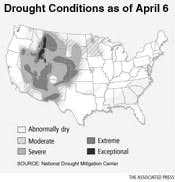A relentless drought continues to ravage the Western United States as dry weather and the early shrinking of a once-promising snowpack are leading to dwindling water supplies.
Many of the states in the drought zone, which stretches from Montana to New Mexico, are facing their sixth or seventh year of drought.
An unusually warm, dry March melted snowpacks and increased wildfire threats, especially in southeast Oregon, half of Arizona, most of New Mexico and parts of Colorado.
Those states along with Nevada, Montana, Utah and Wyoming are heavily dependent on melting snow for water supplies, snow that has rapidly disappeared the past month across the region.
Snowpack showed half or less the normal March precipitation level in the Intermountain West, Southwest, northern Rockies, central Idaho, Oregon and California. The driest basins were in central Arizona, where less than 70 percent of normal seasonal precipitation was reported.
"A lot of places had near-average snowpack. But we had one of the warmest Marches on record across, and we didn't get any precipitation almost anywhere in the West," said Kelly Redmond, regional climatologist for the Desert Research Institute's Western Regional Climate Center in Reno.
The U.S. Natural Resources Conservation Service forecasts the potential for water restrictions and widespread crop and pasture losses in central Nevada, southern Idaho, most of south-central Montana and eastern and southwestern Utah.
Arizona is on the verge of its worst drought in recorded history, according to John Sullivan, associate general manager of the Salt River Project's water group.
For nine years running, precipitation and runoff into the Phoenix area's reservoirs have been far less than normal, and the state has recorded four of its five driest years of the century in the past 10 years, hydrologist Charlie Ester said.
Lack of water has raised concerns about moisture in the soils and forests and the potential for another year of raging wildfires.
"In that respect, Southern California is not doing particularly well. They've had quite a few dry years in a row and certainly didn't do much catch-up this season," said Frank Gehrke, chief of snow surveys for the California Department of Water Resources.
Source: Las Vegas Review Journal


